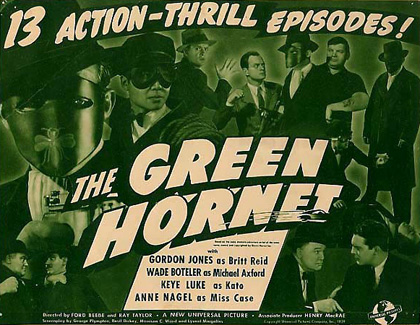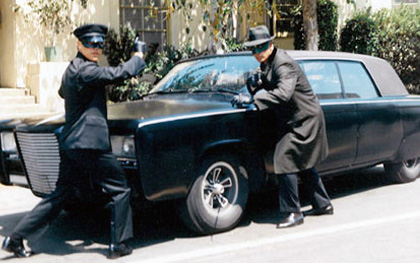Close up
The Green Hornet sells out!

Urban scion of the Lone Ranger, The Green Hornet has long skulked in the shadows of other masked crusaders. As Sony, Seth Rogen and Michel Gondry attempt to revive his profile, Kim Newman tracks the character’s journey from radio days to 21st-century big-screen vacuity
Web exclusive, 14 January 2011
Some properties are developed as movies almost on auto-pilot, when rights-holders keep nagging that something should be done with a potential franchise or a certain number of marketable features are in evidence.
The Green Hornet was created for a radio adventure series in 1936 by Fran Striker and George W. Trendle, who took the format of the already-running Lone Ranger show and transposed it from the lawless Old West to a corruption-ridden big city. Britt Reid, the playboy publisher who dons a mask and poses as a criminal to fight entrenched racketeers, is the great-nephew of John Reid, the Lone Ranger’s alter ego. Instead of Indian sidekick Tonto, Britt has Japanese sidekick Kato (later Filipino, Korean or Chinese, thanks to WWII making Japanese heroes unsellable); instead of a super-horse, Silver, he has a super-car, the Black Beauty (named after a horse); instead of firing silver bullets sparingly to preserve life even in a firefight, he uses a gas-gun to knock out but not kill his enemies; instead of Rossini’s breathless William Tell Overture as a theme tune, he has Rimsky-Korsakoff’s even-more-urgent Flight of the Bumble Bee.

Warren Hull in The Green Hornet Strikes Again! (1940)
Like other pulp heroes of the 1930s – including the Shadow, Doc Savage, the Phantom, Superman and Batman – the Green Hornet was the New Deal in action, pitted against the sort of crookery and mismanagement the Roosevelt administration associated with the eras of Warren G. Harding, Al Capone or Herbert Hoover. The original reason these characters had secret identities was that the law in their cities was compromised, and not to be entirely trusted. Hence the vigilante imposture.
The show ran until 1952, and inspired two Universal serials, The Green Hornet (1940), with Gordon Jones as Britt Reid (but the radio star Al Hodge dubbing the Hornet when a succession of stuntmen put on the mask and hat to indulge in fight scenes), and The Green Hornet Strikes Back (aka The Green Hornet Strikes Again!, 1940), with Warren Hull as the hero. In these, Kato was played by Charlie Chan’s erstwhile Number One son Keye Luke, adopting a silly accent.
The franchise would have petered out and been forgotten among so many lookalike masked men were it not for the success in the mid-60s of the camp Batman TV show, which inspired producer William H. Dozier to scout around for a stable-mate hero. The bland Van Williams appeared as the Green Hornet, teaming up with Batman, in three episodes of the more famous hero’s show, and starred in a single-season series (1966) of half-hour adventures notable only for the casting of future martial-arts superstar Bruce Lee as a high-kicking Kato and a splendid mutation of the Rimsky-Korsakoff theme by Billy May, with virtuoso trumpet work by Al Hirt (the 45 rpm single version of the theme is used effectively in Kill Bill Vol 1).

Bruce Lee and Van Williams in The Green Hornet (1966)
By the time The Green Hornet aired, the Batmania boom was fading; Dinky, having made a mint off the Batmobile and Batboat, licensed the Black Beauty and put out a UK toy, only to be infuriated when British television didn’t buy the series. The presence of the promotable Lee meant that TV episodes were recycled as fake features in the 1970s, and kept a show everyone thought was unsuccessful on the air in reruns.
The reason The Green Hornet has been on Sony’s to-do list for decades is that it ticks two boxes: it is at once a superhero franchise suitable for the sort of big-budget reimagining that has kept Superman, Batman, Spider-Man and a handful of others in the box-office charts (with detritus like Jonah Hex (2010), Legend of the Lone Ranger (1981) and The Spirit (2008) best skipped over), and a remake of a cult TV show which can be spun as a camp comedy (like The Brady Bunch, Starsky & Hutch and The A-Team).
Though previous script drafts went for straightforward superhero adventure, star/co-writer Seth Rogen has worked The Green Hornet over as a spoof, on the assumption that what worked for Batman in 1966 will work for a character who frankly has far fewer fans ready to picket theatres if the hero is desecrated.

Jay Chou and Seth Rogen in Michel Gondry’s The Green Hornet (2011)
With Michel Gondry on board – presumably hoping to direct a film seen by more people than went to all his others put together – the results are pleasant but lightweight. The basic joke is that the Hornet is a hero consistently outclassed by his sidekick: Kato (Jay Chou) does kung fu, invents the gadget, builds and drives the car and even makes more time with the Lois Lite heroine (Cameron Diaz), while Britt is so useless in a fight he has to be given the ’fart gun’ to even things up. It’s an approach which allows for the large-scale destruction and clean-up-the-town melodramatics expected of a comic-book movie (there have been Green Hornet comics, though he’s not primarily a comics hero), in between the bickering bromance comedy which Rogen breezes through on a charm and which makes even his duff jokes worth a smile.
Perhaps the most peculiar fallout is that newspaperman Mike Axford – in all previous incarnations of the franchise the Irish comedy relief character – is now played by Edward James Olmos as the Commissioner Gordon-like straight moral centre of the whirlwind insanity of our hero’s overgrown adolescence.
What’s missing is a context. In the 1930s, there was a reason for The Green Hornet to exist as a character and a series: Britt Reid was exposing and battling real rackets (a typical radio episode deals with a crooked bus company sabotaging the city’s public transport to cut in on profits). Now Rogen’s Britt takes on an identity to which he is completely unsuited just because it seems momentarily cool, good for a few giggles and comes with a really rad car.
‘The Green Hornet’ is released in the UK on 14 January.
See also
From strip to screen: Guillaume Gendron charts the fortunes of two generations of French comic-strip mavericks at the movies (August 2010)
Superbad reviewed by Ryan Gilbey (November 2007)
Batman Begins reviewed by Edward Lawrenson (July 2005)
Hellboy reviewed by Kim Newman (September 2004)
American Splendor reviewed by Xan Brooks (January 2004)
X-Men 2 reviewed by Kim Newman (June 2003)
Spiderman reviewed by Kim Newman (July 2002)
The Innovators 1930-1940: The Thin Black Line: Harvey Deneroff on the Fleischer brothers’ animation studio (June 1999)
